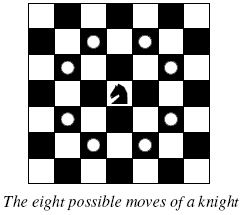A Knight's Journey
| Time Limit: 1000MS | Memory Limit: 65536K | |
| Total Submissions: 26133 | Accepted: 8923 |
Description
 Background
Background The knight is getting bored of seeing the same black and white squares again and again and has decided to make a journey
around the world. Whenever a knight moves, it is two squares in one direction and one square perpendicular to this. The world of a knight is the chessboard he is living on. Our knight lives on a chessboard that has a smaller area than a regular 8 * 8 board, but it is still rectangular. Can you help this adventurous knight to make travel plans?
Problem
Find a path such that the knight visits every square once. The knight can start and end on any square of the board.
Input
The input begins with a positive integer n in the first line. The following lines contain n test cases. Each test case consists of a single line with two positive integers p and q, such that 1 <= p * q <= 26. This represents a p * q chessboard, where p describes
how many different square numbers 1, . . . , p exist, q describes how many different square letters exist. These are the first q letters of the Latin alphabet: A, . . .
Output
The output for every scenario begins with a line containing "Scenario #i:", where i is the number of the scenario starting at 1. Then print a single line containing the lexicographically first path that visits all squares of the chessboard with knight moves
followed by an empty line. The path should be given on a single line by concatenating the names of the visited squares. Each square name consists of a capital letter followed by a number.
If no such path exist, you should output impossible on a single line.
If no such path exist, you should output impossible on a single line.
Sample Input
3 1 1 2 3 4 3
Sample Output
Scenario #1: A1 Scenario #2: impossible Scenario #3: A1B3C1A2B4C2A3B1C3A4B2C4
题意是国际象棋中的马按照图示方法走,对给定大小的棋盘,判断能否走完棋盘,若能输出走的路径,不能输出possible
用DFS做,依次检查每个点,判断最终步数step是否等于棋盘大小p*q;
用dir[][]二维数组来表示马的下一步走向,简化了操作。
代码如下:
<pre code_snippet_id="288901" snippet_file_name="blog_20140412_7_9349528" name="code" class="cpp">#include<stdio.h>
#define max 27
int p,q,sign,step;
int map[max][max];//用map数组的值判断某个点是否遍历过
int sx[max],sy[max];//用这两个数组记录某点的坐标
int dir[8][2]={{-2,-1},{-2,1},{-1,-2},{-1,2},{1,-2},{1,2},{2,-1},{2,1}};//二维数组用于移动表示
void dfs(int i,int j);
int main(void)
{
int t,j,i,n;
scanf("%d",&n);
t=1;
while(n--)
{
sign=0;//用sign标志判断是否完成所有遍历
step=0;//记录当前遍历点的个数
scanf("%d%d",&p,&q);
for(i=1;i<=p;i++)
{
for(j=1;j<=q;j++)
map[i][j]=0;//将所有点置为未遍历状态
}
dfs(1,1);
printf("Scenario #%d:\n",t++);
if(sign)
{
for(i=1;i<=p*q;i++)
printf("%c%d",sy[i]+64,sx[i]);
printf("\n");
}
else
printf("impossible\n");
if(n)
printf("\n");
}
return 0;
}
void dfs(int i,int j)
{
int k,x,y;
if(sign)
return ;
step++;
sx[step]=i;
sy[step]=j;
if(step==p*q)
{
sign=1;
return;
}
map[i][j]=1;
for(k=0;k<8;k++)
{
x=i+dir[k][1];
y=j+dir[k][0];//重新记录当前点的坐标
if(map[x][y]==0 && x>0 && x<=p && y>0 && y<=q)
{
dfs(x,y);//判断当前点为未遍历点,从这点开始dfs
step--;//退出当前对该分支的遍历
}
}
map[i][j]=0;
}

























 被折叠的 条评论
为什么被折叠?
被折叠的 条评论
为什么被折叠?








